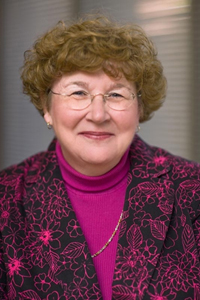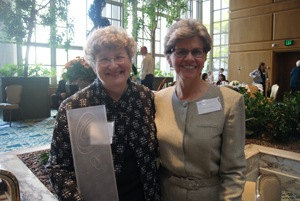
Author: Peta Owens-Liston
Our final journey in life will come. For thousands of patients and families, this final stage has been made less difficult and more comfortable with the care and insights that Patricia Berry, PhD, RN, has provided. Over a 40-year career, she has directly touched the lives of patients and their families or through the students she has taught over the last 10 years as an Associate Professor in the University of Utah’s College of Nursing. “To do this right, you must gently bear witness and be present in a way that allows you to be there for patients and their families, going beyond just the ‘doing’ of care.”
After 35 years in palliative and end-of-life care, Berry was recognized for her commitment and innovations in this specialty. The Hospice and Palliative Nurses Association (HPNA) recently named Berry as the recipient of its 2013 Distinguished Career Achievement Award, and in September, she received the Sojourns Award from the Cambia Health Foundation. The latter included a $50,000 grant, which Berry allocated to Caring Connections, a program in the U’s College of Nursing that provides grief support and education. “This grant will help Caring Connections develop evidence-based training materials for grief group facilitation and support the clinical education of students in health care professions,” explains Director Katherine Supiano, PhD, LCSW.
Some of Berry’s accomplishments include developing an innovative end-of-life care class for graduate students, co-developing the One Minute Pain Questionnaire, and helping create the first certification exam for advanced practice nurses in palliative care. She has authored more than 50 articles, books and book chapters on palliative and end-of-life care, and helped found the first hospice in the Intermountain West in 1977.

“For many patients, nurses are at the heart of their palliative care experience. They help minimize the patient’s pain and suffering, make sure a patient’s care preferences are honored, and provide emotional support to the patient and family,” says Peggy Maguire, Cambia Health Foundation board chair. “Dr. Berry’s work, and her gift to the Caring Connection, means more Utahns will have the end-of-life experience they want and deserve.”
Q & A
Surprised? When I received the award I was pleased, shocked and of course honored. When I saw who the other recipients were in other regions, it was pretty humbling.
Caring Connections was a logical place for the award since they provide bereavement and grieving services. This organization also impacts the way graduate and undergraduates are educated in end-of-life care–something I feel strongly about.
A new model for an end-of-life class? This graduate class is now in its 8th year. However, when we developed it, the class was the first course of its kind in the country because it used an interdisciplinary educational approach. Three professors, from three different disciplines—nursing, social work and pharmacy—helped teach it and the students were from all these disciplines as well.
We want the students to realize that taking care of patients and families at end of life is best done by a team of people; people’s needs are so complicated and diverse that no one discipline can or should meet these needs alone. The faculty in this class modeled this interdisciplinary team for students, who collaborated with other students from these other disciplines on case studies and projects.
The biggest outcome surprise? We assumed the students knew what the roles were of the social worker, pharmacist, and nurse. But they didn’t—we would hear from them that ‘they finally understood what each other did.’ This is important because to take good care of the patient, you need to know what team ‘resources’ you have and when you should call a social worker or consult a clinical pharmacist, for example. The health sciences is realizing more and more that one discipline can’t do everything so we do hope this is a model for other care providers.
Why this field—it is so sad? I first worked in oncology at the University of Minnesota’s Masonic Cancer Hospital when most people would die from cancer because our treatments were fewer. At the time, we didn’t know a lot about symptom management or how to help people die well. While there, two mentors really influenced me—my nurse manager, Kay Carlson, and an older nurse, Kitty Smith. The latter went on and founded the first hospice program in Minneapolis/St. Paul.
I’ve been lucky, most of my career I’ve been at the right place at the right time and working with people who had a lot of passion for this field.
Mentors insights? Kay helped me realize I was a really good bedside nurse and effective in taking care of patients who were gravely ill. Kitty, taught me that there are lots of ways to be helpful to people and the importance of keeping a sense of humor. With so many different areas in nursing, I feel lucky that I found my place.
What’s a good bedside nurse? You listen more than you talk. You are comfortable being present in the face of uncertainties and willing to stand by people and be a companion. You are willing to be a strong advocate for the patient and help them ‘speak’ when they can’t speak.
Experience as your teacher? I’ve learned how incredibly important the time right before and right after death is for the patient and the family. And you only have one chance to get it right. When people are reaching the end of their lives, details become very important—the way you interact with family, how you take care of someone’s body, the ability to just be present and bare witness in an intense and emotional time.
You need to create an environment where people can be themselves, and avoid expectations of how family members should act. As a nurse you have to let go of how you think things should be. For example, there is no such thing as a normal family. If you assume everybody should get along or love one another in every family, you’ll end up creating an uncomfortable environment. You need to never make assumptions about people’s relationships.
Progress? When I entered nursing in the seventies, the hospice movement was in its early stages and it wasn’t until the eighties that palliative care became a specialty. Now there is nursing and physician certification in palliative care.
Things have really come a long way, and hospice and palliative care encompass far more than just cancer, now these areas include all end-stage diseases. We’ve also become more comfortable talking about prognosis and advance-care planning allowing people to state their preferences.
Myths about pain? There is a belief that aggressively controlling symptoms can hasten death. That is a myth. Research shows that controlling symptoms and initiating palliative care earlier in the disease process lengthens life and enhances quality of life. Everyone thinks there is a pay off that you have to sacrifice quantity to get quality and that is not true. Also, palliative is not necessary just for end-of-life situations; it is also available to treat people with life-limiting illness who are receiving curative treatments.
What will stay with you? Well, I’ve been a nurse for 40 years now and spent 35 of those years in hospice and end-of-life care. I truly value the people I’ve worked with in this field—it attracts incredibly generous people. I find that most of us in this field are humbled by this work and there is not the competitiveness that you’ll find in other fields. I’ve truly learned from all the people I’ve interacted with—patients, families, colleagues, students—and I feel like I’m still learning, constantly.